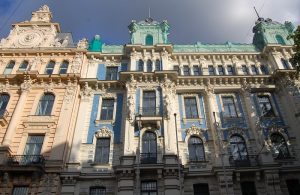Art Nouveau Architecture
Art Nouveau architecture is a style of building that was popular in the late 19th and early 20th centuries. The word “Nouveau” means new, so this style of architecture represents an era of experimentation with different materials, styles and design principles.

This building has housed various banks through the years – currently occupied by some services of the Bank of Portugal. Photo by Bosc d’Anjou.
Art Nouveau buildings are characterised by fluid shapes; nature-inspired motifs; strong horizontal lines; asymmetrical designs with attention to natural light sources. A metal roof is often used for its reflective quality.
Famous architects of the style include Hector Guimard in France and Antoni Gaudí in Spain. The last significant example of Art Nouveau architecture is the Stasi House, designed by Jakob König from 1914 to 1916 in Weimar, Germany.

Image by Henning Klokkeråsen.
One of the most famous examples of Art Nouveau architecture in Australia is the Perth Town Hall. Another example, designed by architect George Oakley Tulloch, is Lickdale House in Quirindi New South Wales.





